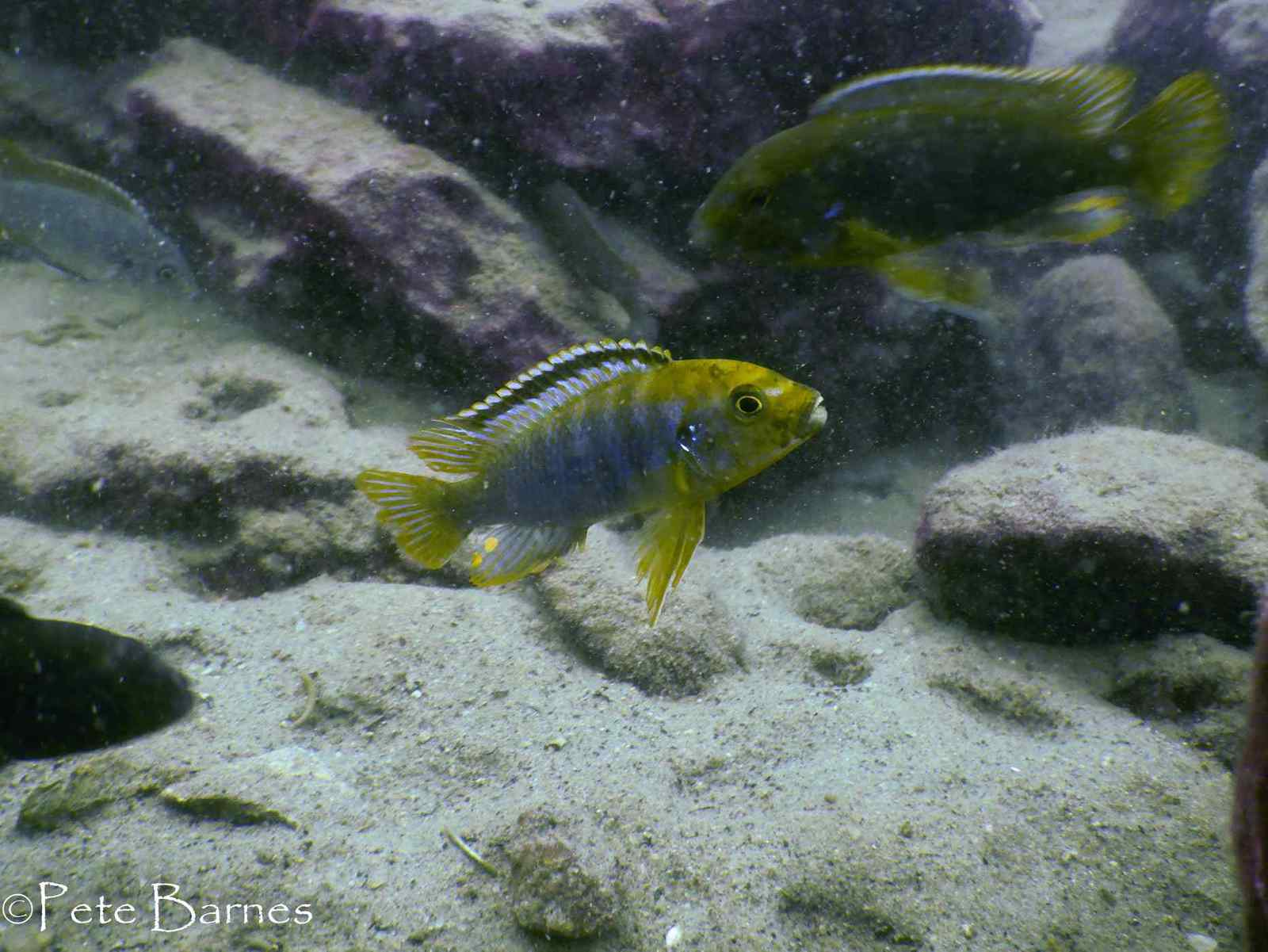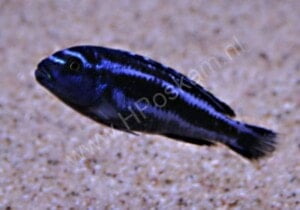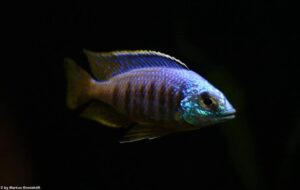Iodotropheus sprengerae – Rusty Cichlid
Iodotropheus sprengerae was first described by Oliver & Loiselle in 1972. The description was motivated by the widespread presence of the fish in the aquarium trade under incorrect names, such as Petrotilapia tridentiger. The naming was done in honor of Mrs. Kappy Sprenger, an experienced aquarist who contributed to the correct identification of the species.
The genus name Iodotropheus is derived from the Greek words“iodes” (rust-colored, also lavender-colored) and“trophos” (food). This refers to the fish’s rust-brown to lavender coloration and its specialized teeth, which are an adaptation to its diet. The species name sprengerae is a tribute to Mrs. Kappy Sprenger. There is not really a Dutch name for this species, in English they are also called Rusty Cichlid, a reference to the rusty brown color.
Synonyms: Iodochromis sprengerae and Iodochromis sprengeri.
Description, Behavior and Life Expectancy of Iodotropheus sprengerae
Iodotropheus sprengerae has a robust, elongated body, typical of Mbuna cichlids. The head is round in shape. The ground color is rusty brown to lavender, with a purple glow. The flanks show a faint pattern, sometimes with hints of vertical stripes. The fins are usually the same color as the body, but may be more intensely colored in males. The maximum length is about 12 cm for males and 9 cm for females, although some sources mention a maximum length of 13.5 cm. This may be caused by feeding too much and too vigorous food in the aquarium, which causes some species to grow larger.
Males are generally larger and more colorful than females. They often exhibit an elongated anal fin and more prominent”egg spots” (white dots on the anal fin that resemble eggs and play a role in reproduction ). Behavioral differences are especially apparent during reproduction; males then exhibit territorial behavior, although this is less pronounced than in other Mbuna species. The differences between juveniles and adults are mainly in size and color intensity; young fish are less colorful.
Iodotropheus sprengerae is considered one of the least aggressive Mbuna species. Although males may exhibit some territorial behavior among themselves, it is less pronounced than in other Mbunas . They do not live in strict territories, but prefer rocky areas with lots of hiding places. They are generally not shy and can live well with other peaceful Malawi cichlids, provided there is sufficient space and hiding places. It is recommended to keep one male with several females to minimize aggression.
Life expectancy: Life expectancy in the wild is not explicitly stated in available sources. In an aquarium they can live up to 7 years.
Biotope
Iodotropheus sprengerae inhabits rocky areas in the southeastern part of Lake Malawi, around the islands of Boadzulu, Chinyankwazi and Chinyamwezi. These areas are at a depth of about 15-18 meters. The natural habitat is characterized by a lack of aquatic plants, although a rich layer of algae (aufwuchs) may be present on the rocks. The bottom consists of rocks and a sandy bottom.
Lake Malawi has a tropical climate with little seasonal variation in temperature. Due to the size and depth of the lake, water values are very stable throughout the year.

This variant was described by Jay Staufer as Iodotropheus declivitas and considered by Ad Konings as a junior synonym.
Diet
Diet in the wild: Iodotropheus sprengerae is an omnivore that in the wild feeds on a varied diet consisting of algae (aufwuchs), small invertebrates and detritus (organic waste). Their specialized teeth are adapted to scraping algae from rocks.
Diet in the aquarium: A varied diet can be offered in an aqu arium , including spirulina flakes, cichlid pellets, live foods (such as cyclops and daphnia), frozen foods and green foods. Carotene-rich foods contribute to color. Overfeeding should be avoided to prevent water pollution.
The Aquarium
A group consisting of one male and several females (for example, three or four) requires an aquarium at least 120 centimeters in length. For multiple males, an even larger aquarium is recommended, at least 150 centimeters.
Furnish the aquarium with many rocks between which you create dens and crevices, this is important to provide them with hiding places. Plants are not necessary because the fish usually damage them. If you want to keep plants, then sturdy plants such as Java fern and Anubias are recommended. A sandy bottom is appreciated.
Water values: Hard, alkaline water is recommended, with a pH between 7.5 and 8.5 and a hardness (dH) of up to 20 degrees. The temperature may be between 22°C and 26°C .
Compatibility: The Iodotropheus sprengerae is a relatively peaceful Mbuna, but males can be somewhat aggressive among themselves. They can live well with other peaceful Malawi cichlids, provided there is sufficient space and hiding places. However, larger, more dominant species may pose a threat. Suitable co-inhabitants may include: Aulonocara, Protomelas or Copadichromis species and other peaceful Malawi cichlids such as Labidochromis caerulus.
Breeding Iodotropheus sprengerae
The breeding of the Iodotropheus sprengerae is quite simple. The fish mate with each other and then the eggs are deposited. Then the female takes the eggs into her mouth and these are fertilized by the male using the egg-spotting method. It is about 20 eggs at a time that are hatched in the mouth of the female.Just a brief explanation about the egg-spotting method. When the female takes the eggs into the mouth they are not yet fertilized. This is where the male has found a way. He has on his anal fin so-called egg spots (white dots). These spots look like eggs which makes the female think she has forgotten eggs. She hooks onto the anal fin to take it into her mouth and then the male repels homing fluid, fertilizing the eggs in the female’s mouth.
After the eggs hatch, they remain in the mouth of the female. After about three weeks, the eggs are released and can be reared with artemia nauplii, rearing food and finely rubbed dry food.
Conclusion
Iodotropheus sprengerae is a relatively peaceful and easy to keep Mbuna cichlid, suitable for both novice and experienced aquarists. A spacious, rocky setup with a sandy bottom is essential, as well as hard, alkaline water at the right temperature. A varied diet and regular water changes are crucial to their health and well-being. Although they are less territorial than other Mbuna’s, it is advisable to keep one male with several females to minimize aggression.
A notable feature is their relative peacefulness compared to other Mbunas, and the”egg spot method” of fertilization. Breeding is relatively easy, but requires attention to proper water parameters and nutrition. Overall , the Iodotropheus sprengerae is an attractive and relatively easy to keep fish that can be a valuable addition to a community tank with other peaceful Malawi cichlids.
Video
Authors
Kevin
John de Lange
Copyright images
Toni Wagner – Tonis-africancichlids.de
J. de Lange
Pete Barnes











